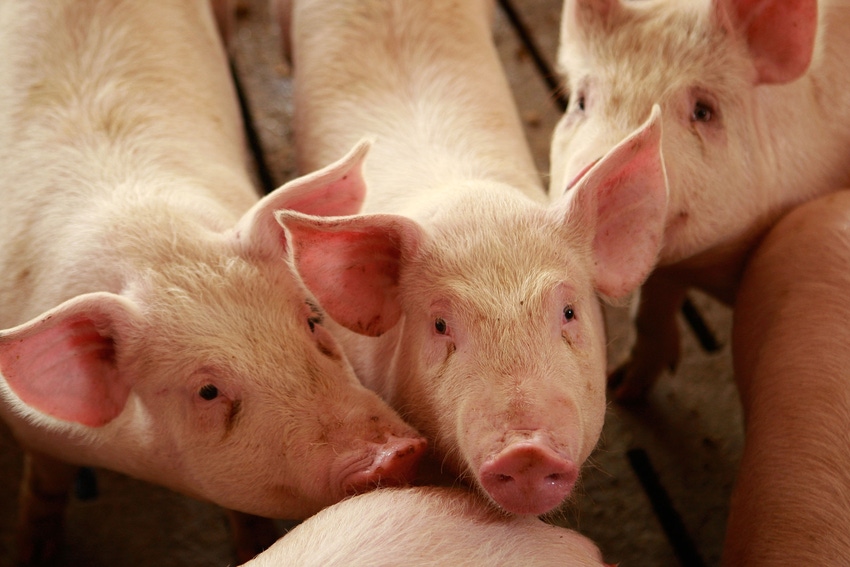More bearish news for hog producers
Feed costs may moderate, giving hog producers some relief.
April 3, 2024

By Jason Franken, farmdoc daily
The USDA’s March “Hogs and Pigs” report places the March 1 inventory of all hogs and pigs at 74.6 million head, down about 1.6% from last quarter, and up about 0.6% from a year ago, compared to pre-report expectations for just 0.1% higher. The market hog inventory is also about 0.8% larger than a year ago, while the breeding herd, which was expected to be down almost 3%, is down only 2.1%. The number of market hogs weighing over 180 pounds is 0.6% lower than at the same time last year, while inventories are up 0.3% for the 120-179 weight class in contrast to expectations for a 1.0% decrease, making inventories slightly higher than expected for the two upper weight classes, while the two lower weight classes are both up 1.5% from a year ago. Overall, the number of hogs weighing less than 180 pounds is up just 1.2% from this time last year, and these will be the market hogs arriving at processing plants from April to August.
The increase in lighter weight hogs partly reflects that December-February pig crop is up 1.9% from a year ago, compared to expectations for a 1.4% increase, as a 2.6% decrease in sows farrowed is again more than offset by productivity gains with 11.53 pigs per litter for the period or 4.6% more than a year ago, compared to expectations of just 3.3% higher. Market hogs from this pig crop will arrive at processors from June to August. Relative to actual farrowings last year, spring and summer farrowing intentions are down by about 0.9% and 1.7%, respectively, which should imply somewhat smaller slaughter numbers in subsequent periods, provided decreased farrowings aren’t again offset by gains in pigs per litter.
Cold stocks of meat appear to be back in a decline. According to the USDA cold storage report, cold stocks of pork at the end of February are down 1% from the previous month and 12% from a year ago. Poultry stocks are down 1% from the prior month and 5% from last year, while beef is down 6% from the prior month and 12% from a year ago.
U.S. per capita pork consumption has been trending downward since 2019 with the USDA estimating it to bottom out at 50.2 pounds per person in 2023 and forecasting it to rise slightly to 50.6 pounds per person in 2024.
Pork exports have been a bright spot with a surge in December of 2023 contributing to a record-breaking year. That was followed by 588 million pounds of pork exported this January, or about 6% more than in January last year. With Mexico again leading the way, up 3.2% from a year ago and accounting for 40% of those shipments, western hemisphere nations accounted for over half of U.S. pork exports in January. With Japan coming in as the second largest buyer at 15% of U.S. pork exports and South Korea buying almost 52% more U.S. pork than a year ago, Asia accounted for nearly a third of U.S. pork exports in January, which reflects fewer purchases of relatively more expensive EU pork afflicted by currently high energy costs in the region. During the week ending March 21, pork exports hit a marketing year high, again driven by strong demand from Mexico, followed by Japan and Australia.
With the strength of recent shipments, the USDA raised estimates of first quarter pork exports in 2024 by 30 million pounds to 1.795 billion pounds or about 7.6% above last year, with second, third, and fourth quarters also expected to be about 1%, 6.6%, and 4% higher than a year ago, respectively. Overall, U.S. pork exports in 2024 are anticipated to be 4.6% higher than in 2023.
Taking all of this into account, along with the USDA’s recent report of producer intentions to plant 4.6 million fewer corn acres this spring and tighter than expected corn stocks, the outlook is fairly bearish for hog producers in 2024. The forecast presented here is for the national weighted average net price on a carcass basis for all transactions for producer-sold barrows and gilts, including negotiated and contract prices. This net price should be more reflective of what producers receive, on average, and normally runs at a premium of about $2.00/cwt. over the base price on average. From December-February, this net price averaged $73.89/cwt. compared to $54.64/cwt. for the corresponding net prices for negotiated or spot transactions.
In general, hog prices tend to be higher in the second and third quarters, with lower prices in the first and fourth quarters. Accordingly, prices are forecast to rise from the average of $73.36/cwt. observed in the first quarter of 2024 to $88.87/cwt. and $93.72/cwt. in the second and third quarters, respectively, before falling to $78.66/cwt. for the final quarter of 2024 and then to $77.55/cwt. for the first quarter of 2025. These projections are consistent with the supply and demand scenario currently anticipated. However, if actual farrowings exceed spring and summer intentions indicated by this “Hogs and Pigs” report or if exports demand falters, then even lower prices may be realized. Conversely, if producers refrain from expansion and exports continue to grow, then prices could improve. Moreover, if realized corn acreage grows from recently reported planting intentions and yields hold through dry periods of a forecasted La Nina, then feed costs may moderate, giving hog producers some relief.
You May Also Like



